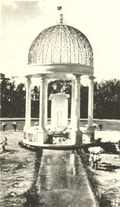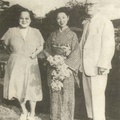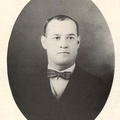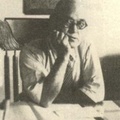>> Part 3
World War II and Its Aftermath
When Japanese forces attacked Pearl Harbor, hundreds of Japanese Americans were arrested as a threat to security and were sent to the concentration camps on the mainland. Many people were surprised that Makino was not among them. Actually, Makino was interrogated by the FBI a few times. But they could find nothing against him to warrant deporting him to the concentration camps. Although Makino was known for his sharp criticism against social injustice, and for his anti-establishment stances, he had sound reason and basis for his actions.
Makino was a law-abiding citizen, he did not break the law, nor was he blindly patriotic of Japan. His opinions and actions were always independent and the authorities could find no relation whatsoever between Makino and the Japanese government. As a resident of the United States, he believed totally in the ideas of American democracy. Makino never went to meetings at the Japanese Consulate, on the pretext that he lived too far away in Kuliouou. So some of the consul generals and consuls never met Makino, even once. Whenever Japanese Navy vessels came into port, he never went to welcome receptions, hence he was sometimes criticized as being anti-Japanese.
Makino visited Japan just once in 1912 to see his mother, who was nearing death. Between 1937 and 1939 Japanese in Hawaii bought a total of 3 million yen in war bonds issued by Japan. They also donated 1.2 million yen toward the Japanese effort. Makino criticized these practices and insisted that Japanese in Hawaii buy bonds issued by the United States government.
Yet another reason why Makino was not sent to the concentration camps was that the FBI was afraid that if they arrested Makino without good cause, he might file a lawsuit against them after the war. So they investigated Makino’s life and his ideas in great detail and found out that his were very close to the ideals of American democracy. Realizing that Makino loved the United States and not Japan, the authorities realized they couldn’t arrest him.
After being shut down at the outbreak of the war, The Hawaii Hochi resumed publication as The Hawaii Herald Hochi on January 8, 1942. Under military authorities, the Hochi cooperated fully in the war effort. On January 11,1952 the paper resumed its original name, The Hawaii Hochi.
Conclusion
After the war, the Hochi began to concentrate on news reports, and its editorials became weak. The Hochi did not take strong stands on a number of strikes led by the ILWU. The change was largely due to the absence of a strong editor. Kosako Hoga, who had been editor-in-chief from 1915 to 1930 died on May 24,1931, leaving no one to fill his shoes. And George Wright, the paper’s English editor since 1925, died on December 10, 1944. Makino had lost the Hochi’s two vital components. Although he still had many ideas and opinions that he wanted desperately to express, he had lost the means by which to convey them in the newspaper.
Also a key figure in the story of Fred Kinzaburo Makino was a lawyer named Joseph Lightfoot, whose legal expertise Makino often enlisted. Lightfoot handled the lawsuit regarding the Japanese language school teachers. Lightfoot also fought the deportation incident involving Kuramoto, and helped obtain U.S. citizenship for war veterans of Japanese ancestry who had fought in World War I.
Lightfoot died shortly after winning the landmark U.S. Supreme Court case regarding the language schools. His passing was major blow to Makino. If Hoga, Wright and Lightfoot had lived longer, Makino would have been able to accomplish more.
In the Fall of 1949, Makino and his wife visited the island of Maui, where he climbed to the top of Haleakala. Two days after returning to Honolulu, he suffered a heart attack. Makino never recovered. On February 17, 1953, at the age of 76, he died at Queen’s Hospital. A Buddhist funeral was held at Nuuanu Memorial Park, where Fred Kinzaburo Makino now rests in a peaceful gazebo setting.

In 1950, Makino visited with Mr. Yukio Ozaki, a veteran Japanese statesman who was instrumental in shaping Meiji and Taisho era Japan.
* This article was originally published by the Hawaii Hochi in commemoration of The Hawaii Hochi, Ltd's 75th Anniversary.
© 1987 Hawaii Hochi, Ltd.








